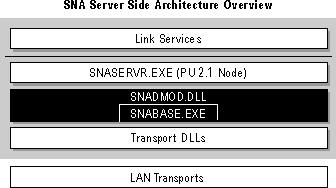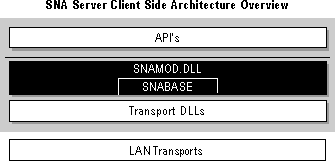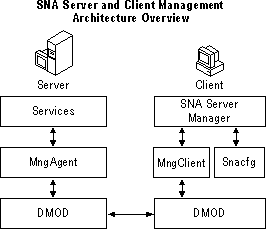
SNA Server was designed to support two kinds of communication: between client and server, and between server and management workstations. Its components allow client computers to communicate with SNA Server computers and vice versa over local-area and wide-area networks. The architecture of SNA Server is best described in two pieces—the client-server architecture and the management architecture—followed by an explanation of how each manages data.
The client-server architecture allows applications to communicate data between server and client computers. It uses the SnaBase, SnaServer, and SnaDMOD services and network protocols such as TCP/IP, and IPX/SPX to achieve communication. Figure 3.1 provides an overview of the server architecture.

Figure 3.1 An overview of SNA Server architecture.
These services work with SnaBase and theWINRUI, WINSLI, WINAPPC, and WINCPIC DLLs to provide SNA Server’s fundamental service: support for applications written to SNA APIs. These APIs run on application clients without the complexity and redundant overhead of a full SNA protocol stack on each client. Figure 3.2 provides an overview of the client architecture.

Figure 3.2 An overview of SNA Server client architecture.
The management architecture in SNA Server uses Manage Agent (MngAgent) and Manage Client (MngCli) to manage services, maintain connections, and transfer information. It supervises the filtering of information transmitted over the LAN to management clients to avoid large bursts of traffic that may swamp the transports. When a change occurs on an SNA Server computer, MngAgent decides whether to send it to the client by means of MngCli. Changes in LU status, the addition of new users, and the starting or stopping of an APPC session are some of the changes that MngAgent monitors and directs. Queues on both server and client computers act as temporary holding areas for data transfer. Figure 3.3 shows how the management architecture allows communication between server and client.

Figure 3.3 An overview of how SNA Server computers and client computers communicate with each other.
The client-server architecture and management architecture use DMOD, a transportation protocol. DMOD is characterized by the following capabilities: